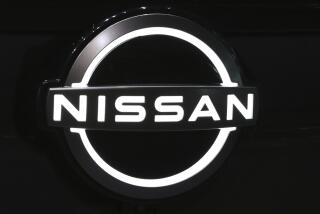Ford Will Put Less-Forceful Air Bags in All Its ’98 Vehicles
WASHINGTON — Ford Motor Co. said Thursday that is installing less-forceful air bags in all of its 1998 model-year vehicles, saying the less-powerful devices will better protect children and short adults.
Air bags deploying at up to 200 mph have been blamed for the deaths of at least 38 children and 25 adults--mostly shorter women in lower-speed accidents they should have survived.
In response to the public outcry, government regulators gave auto makers the go-ahead in March to install air bags in new cars that deploy with up to 35% less force than the current air bags.
The auto industry, which lobbied hard for the change, said then that some of the first cars with the “depowered” air bags could be on the market by late summer.
Ford is the first auto maker to announce that all its vehicles sold in North America will have less-forceful air bags. The change will begin with the 1998 models going into production this summer and fall.
General Motors Corp. will install less- forceful air bags on one-third to one-half of its 1998 model-year vehicles, spokesman Kyle Johnson said. Chrysler Corp. will have the new air bags on more than 50% of its vehicles, spokeswoman Michele Tinson said.
Many foreign auto makers will install less-forceful air bags, said George Parker of the Assn. of International Automobile Manufacturers. But, he added, not all air bags need to be made less forceful, because their inflation speeds vary. “Some air bags are already very benign compared to others,” he said.
For example, smaller cars in general require more forceful air bags, as do many autos, such as sport-utility vehicles, with stiffer body frames, auto executives say.
Ford shares closed down 50 cents at $34.375; GM shares eased 87.5 cents to close at $55.50; and Chrysler shares dropped 50 cents to close at $30. All trade on the New York Stock Exchange.
Ford was the auto industry’s first proponent of less-powerful air bags in 1995. In August 1996, U.S. auto makers formally petitioned the government to allow them.
The National Highway Traffic Safety Administration estimates that air bags have saved more than 1,800 lives since 1986. But concerns have grown about the risks they pose, especially to children in the front passenger seat and small-statured drivers sitting close to the steering wheel.
Most of those injured by air bags were not wearing seat belts or were wearing them improperly, and were thrust against the dashboard by braking as the air bag deployed in a crash.
“Even though these bags have lower power, there still is a risk from a deployment to occupants who aren’t wearing seat belts or who are positioned too close to the air-bag module,” said Helen Petrauskas, Ford’s vice president of environmental and safety engineering.
Auto and government officials have repeatedly urged passengers to always wear seat belts, never put an infant seat in front of an air bag, and have children under age 13 sit in the back seat.
Government officials say some children still could be killed by the new air bags, and that some adults may die in crashes they might have survived had the government decided not to allow auto makers to install less-forceful bags.
Domestic auto makers dispute that, saying that perhaps no adult lives will be lost due to less-powerful air bags.






